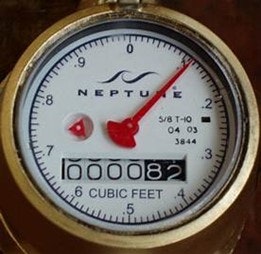How to Read your Water Meter
Inverness Public Utility District Water System
HOW TO READ YOUR WATER METER
You can keep track of your water usage and see how much water you are using over time by learning how to read your water meter.

First, locate your meter. It is most likely in front of your house, a ways in from the street. Hint: If you see a splotch of blue paint at the edge of the roadway, that is probably a guide to our meter readers telling them that your meter is inboard from that spot. If you can’t find the meter, phone IPUD at (415) 669-1414 and we’ll help.
You’ll need a screwdriver to remove the lid, as shown in the picture.
Scoop out any dirt inside the box that is covering up the meter – the ubiquitous gophers like to store their excavations in our meter boxes! Once you’ve exposed the
meter, lift up the hinged brass cover so you can view the meter’s dial. An example of a typical meter dial used in Inverness is shown below. Yours may not look exactly like the picture, but it’ll be similar.

The sweep hand (red in this example) advances like the second hand on a clock whenever water is passing through the meter. It measures about 3/4s of a gallon each time it moves from one number to the next around the face of the dial. A complete revolution indicates exactly 7.48 gallons (or one cubic foot of water).
Each time the hand comes all the way around to the “0” at the top, the rightmost digit on the readout window clicks to the next digit, like the odometer in your car. This tells you that 1 cubic foot has been used.
To find out how many gallons of water you use in a day, start by writing down the reading – note all the digits, such as “000082” in the picture. Wait 24 hours and read the meter again. Let’s say the second reading is “000103.” Subtract the first reading from the second reading, which will tell you how many cubic feet of water were used between the two readings. In this case, 103 - 82 = 21 (cubic feet). Multiply this result by 7.48 to get the usage in gallons; in this example, the answer would be 157.08 gallons (21 ´ 7.48 = 157.08).
NOTE: Whenever you check your meter, please be sure to close the brass lid over the meter dial when you are done and before you replace the lid on the meter box.
Checking for a leak. If you think you might have a leak somewhere, shut off all faucets and plumbing fixtures, both indoors and outdoors. Now, look at the meter dial. Is the little red triangle turning or is it still? If it isn’t moving at all, you don’t have a leak. If it’s moving, water is flowing through the meter. Either you missed turning off something or water is running somewhere where it shouldn’t be (running toilet? leaky faucet? cracked pipe or weeping joint? underground pipe leak?). if you can’t find the source, use the procedure above to determine how much water is being lost and call a plumber if necessary. You can always call us at (415) 669-1414 if you need help (especially in the event of a large leak and you need us to turn the water off entirely).
Not all meters have the red leak indicator shown in the picture. In such a case, use a pencil to mark on the dial the location of the sweep hand (or write down exactly where the sweep hand Is located). Wait 30 minutes and check the meter again. If the sweep hand has moved at all, some water has flowed and you likely have a leak.
